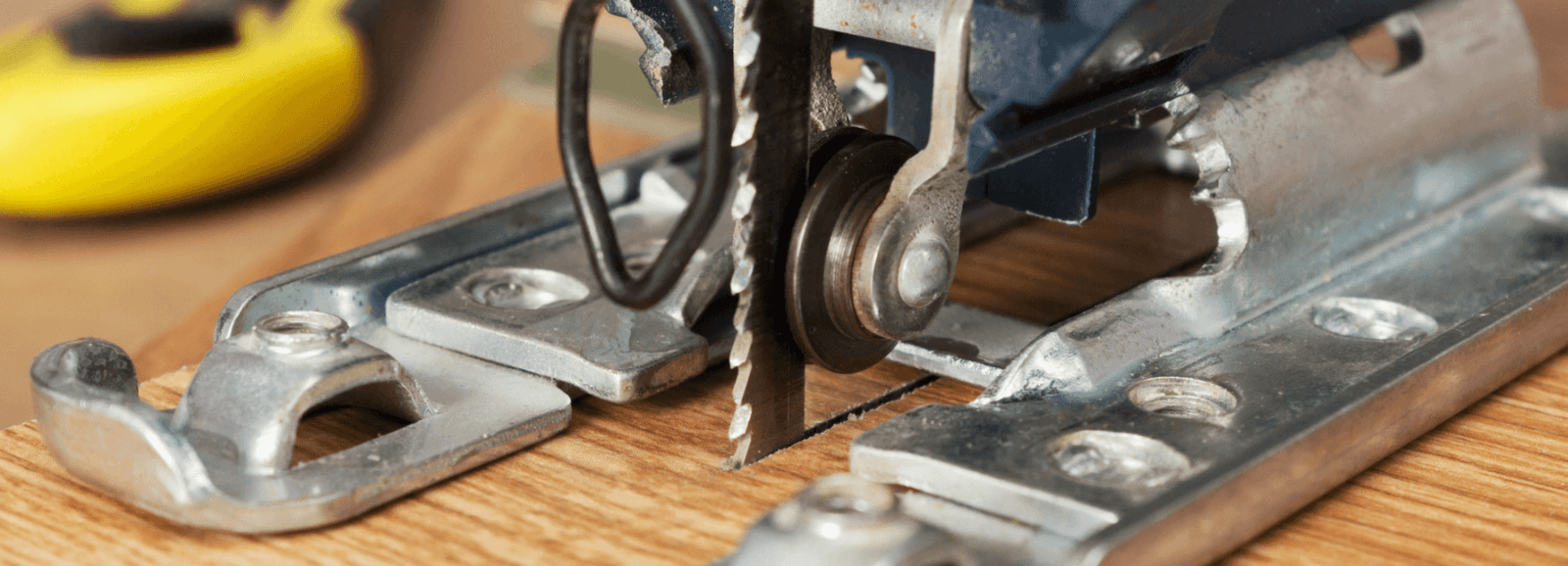
While picking the jigsaw for your various wood and metal projects, it is important to know what types of jigsaw blades it supports. The best jigsaw blade for wood differs from the one for metal so consider beforehand what kind of material you will use. The one for plywood might work great on straight wood cutting but be useless for the curved fine cuts. Besides, even the best blades might not fit the certain jigsaw, because of the difference in shank types.
The blades vary by the way they are fixed in the tool. In general, there are two jigsaw blade types: T-shank or U-shank ones.
- U-shank. Not a widely used model nowadays. They have a semicircle shape at the end reminding of the “U” letter. These blades are quite flexible; yet, they don’t last long and tend to wobble while cutting. If choosing the U-shank blades, it is advisable to get ones with more teeth — they wear out slower. To install or remove these blades, a wrench is needed.
- T-shank. Most of the modern jigsaws apply this type. They have a division at their end reminding of a “T” letter. These blades are fixed reliably in the tool. To date, these are the most popular type of jigsaw blades.
Jigsaw Blades Reviews
T-shank Blades
Dewalt DW3742C – best jigsaw blade for wood
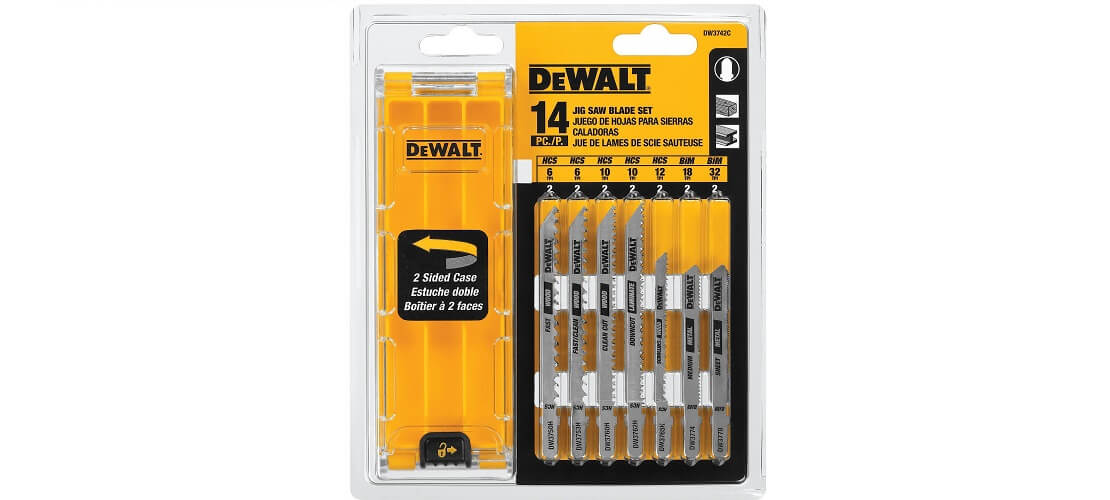
The middle-class set includes 14 blades of various types. There is a sturdy saber saw blade having six teeth per inch and slicing the wood effortlessly, with a single blunt stroke. There are sophisticated metal- and wood-bound items having 32 TPI put at a different angle and order. They are especially good at thin curved and cross cuts.
These DEWALT jigsaw blades have a different length, which is great for applying them to the materials of various thicknesses. The 3-inch 18 TPI blades go steadily through the metal leaving clean dust-free cuts. The T shank shape blades can be inserted and work with different jigsaw models without issues.
Pros
- Four sturdy bi-metal blades for metalwork and ten high carbon steel ones for wood and laminate.
- Each blade is clearly marked stating the material it works with, the TPI number, length, and the type of cuts it is best at.
- The transparent two-sided case is handy for storing blades.
Cons
- The metal-bound blades can bend if applied for quick cutting – however, it is impressive at a slow job.
- The lids of the blades’ case can slide away occasionally due to the insufficient latches.
Bosch T5002– best jigsaw blade for plastic
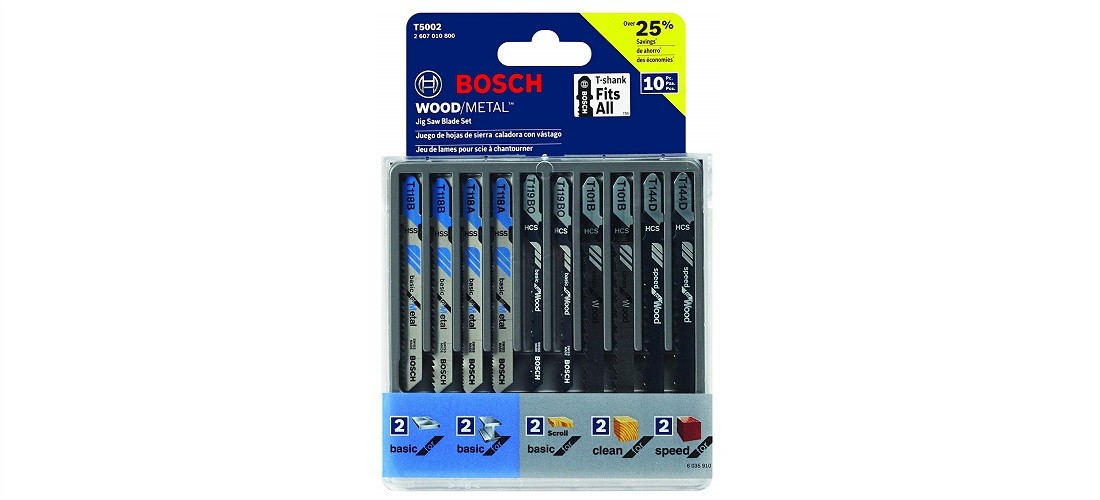
This affordable pack contains various blades for different types of materials. There are four basic jigsaw metal cutting blades and three pairs for woodwork. Two pairs have larger teeth and are designed for quick straight cutting. Among them, two blades have a wave-like set of teeth enabling cleaner cut and less effort applied when working. Two blades feature higher TPC and serve for the curved cuts. All blades feel sturdy and reliable.
The blades have the “T” division of the shank and can be applied in the modern jigsaw tools: Bosch, Makita, Craftsman, Milwaukee, and Dewalt. Though some effort must be applied to have the blade lock-in, it sticks and works confidently.
Pros
- The metal-bound blades differ in TPI and can deal with thin and thick metals.
- No splintering even at the multi-layer materials like plywood, laminate, etc.
- The plastic storage case is convenient for keeping the blades in one place.
Cons
- When used on hard tasks (like thick ferrous metals), the blades become less responsive upon a while and require more effort to cut.
- No plastic-bound blades included.
WorkPro W124142A
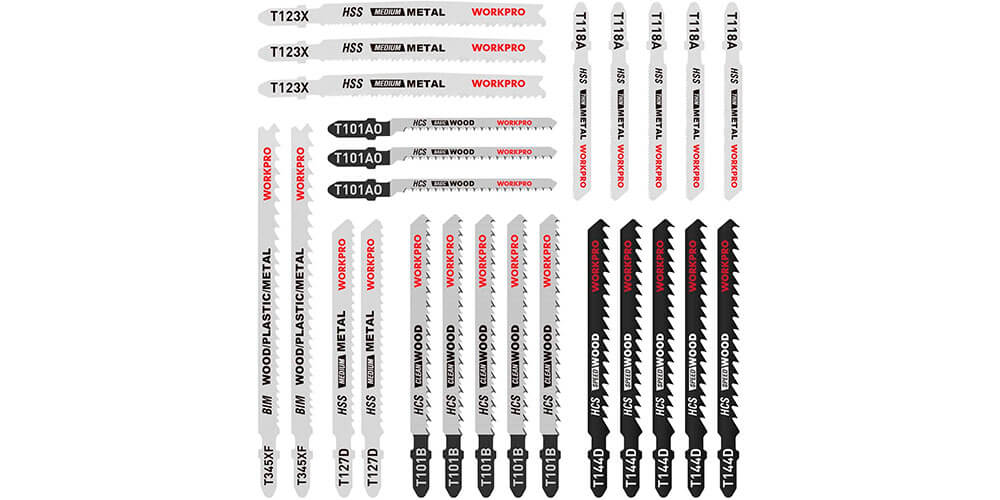
There is no need to look for the best jigsaw blade for laminate flooring since one can acquire a whole set of 25 blades of different sizes with a tang at the top of their shank to fit most of the jigsaws. They provide the fastest way of blade changing, even with a single push of a button in the latest jigsaw models. The blades can work not only on laminate surfaces, but also on plastic, wood, and metal.
The blades are sharp, and they keep their edges sharp even after lots of cutting, coping with both DIY and professional tasks. They are durable and don’t break under heavy loads.
The set contains CRV blades with the improved cleanliness for general-purpose cutting of wood, laminates, and plywood. There are also HSS blades for hardwoods, metal, or reinforced plastic, and BIM blades for heavy-duty work on metal and hardwoods. The blades feature various TPI (number of teeth per inch) to handle materials of different thicknesses.
Pros
- The set comes in a square ribbed case made of hard plastic to access any blade fast and to keep all of them well organized.
- Each blade is labeled to show its purpose.
Cons
- They work slowly on metal stuff.
- No blades with TPI of 32 and 36 for cutting hard and thick materials.
Bosch T101AO3 – best jigsaw blade for plywood

This small expensive set boasts three top-quality blades for wood cutting. The high-carbon steel blades have a narrow design to provide a clean splinter-free cut. The 20 TPI ensures the usage for soft multi-layer materials like double-sides laminate and on harder workpieces like solid wood or MDF boards.
The scroll cutting is the primary purpose of these blades. The blade pierces the wood easily and moves steadily, it allows making sharp angle cuts or wavy ones equally smoothly. The teeth are sharp-pointed providing fast blade motion and leaving very little sawdust behind. Among different types of jigsaw blades, this specific T-shank set is tailor-cut for curved wood-cutting.
Pros
- The length of 3-¼ inches fits many modern jigsaws; yet, ensuring the full control over the blade motion.
- Solid work without getting dull for long even at the hardwood.
- The blades are easy to insert and remove; no tools are needed.
Cons
- The blades are curved below the shank that might cause issues with some jigsaw tool models.
- The cardboard package wears out quickly and is unhandy to store and pick the blades.
U-shank Blades
Black & Decker 75-626 – best jigsaw blade for scrolling
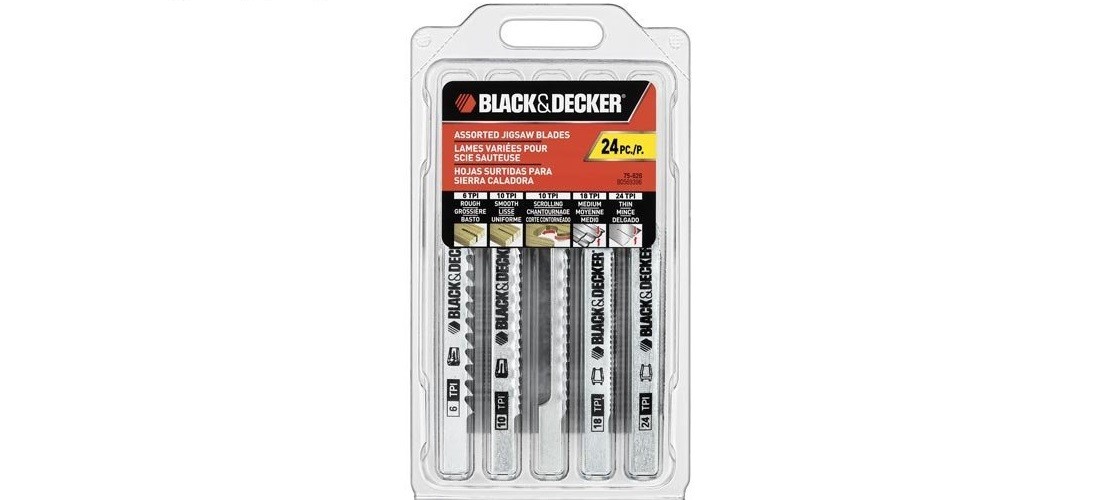
The inexpensive U-shank package offers 24 blades for metal and woodworking. The case contains both the Black and Decker jigsaw blades for straight cuts and the units for curved ones. The TPI varies from 6 to 24. The blades with higher TPI deal with the aluminum medium sheets smoothly, making the precise cuts.
The package has blades with large pointed teeth placed at six per inch that slices the hardwood without effort. The blade with the tiny teeth makes smoother and narrower cuts and fits the softer materials like laminate. The scrolling blade is thin and has small teeth letting it make angles and curves in the wood.
Pros
- The blades can work heavily at plywood and solid cedar wood without getting dull.
- Can saw efficiently through plastic (PVC) as well.
- Each blade is labeled with the TPI number and sawing purpose / material.
Cons
- The blades are quite short – it is problematic to cut anything more than 1-½ inches.
- Fast work might lead to blades’ bending.
Milwaukee 49-22-1168
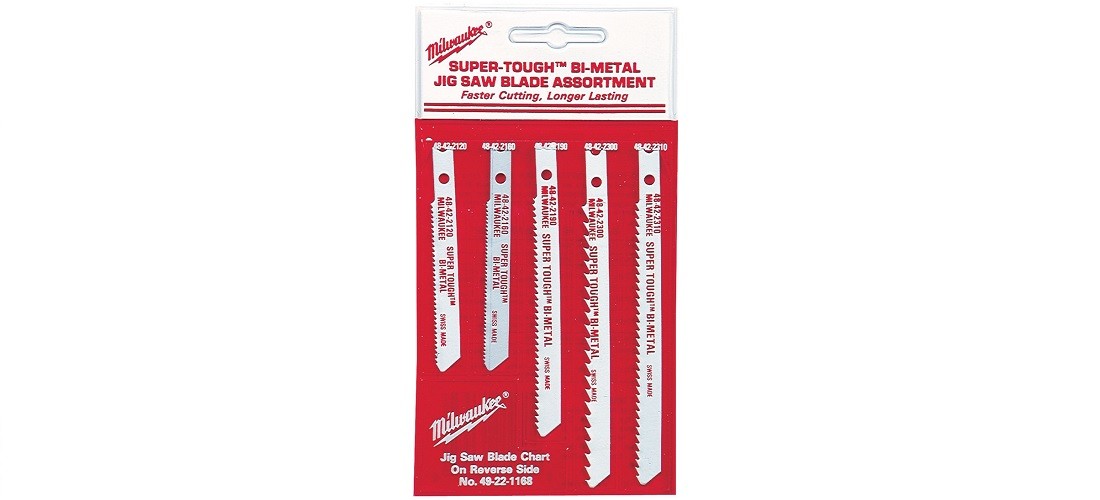
This middle-priced five-pieces set holds durable strong blades fit for sawing through metal, plastic, and wood. They vary in length and TPI. The units have bi-metal build and can get through the toughest materials.
The set contains three items for sawing metals and two – for woodworking. The wood-bound blades are longer and have large and large-to-middle teeth that are good for sawing through solid hardwood or plywood. These jigsaw blades for wood are shorter and have smaller teeth that deal easily with metal sheets (both ferrous and non-ferrous), as well as with plastic. All blades are 9/32 inches wide and fit the tools with U-shank clamps.
Pros
- The carbon coating and quality HCS steel provide long-lasting heavy-duty work.
- The enforced 48-42-2310 blade can saw through the nail-embedded wood without breakage or bending.
- The blue-painted 48-42-2160 jigsaw metal blade cuts through tile smoothly exposing little of dust.
Cons
- No scrolling blades are included.
- The package is unhandy for storing the already used blades.
Task Tools 09962
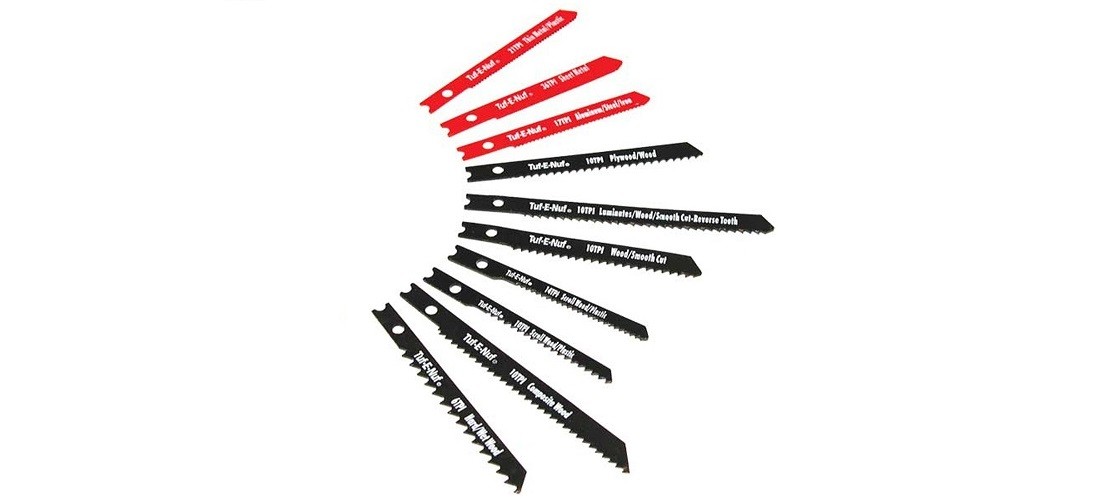
The affordable kit of 20 blades for composites and wood is versatile. It holds the blades that saw through wet wood and hardwood and can cut wood derivatives. The blades have different length and number of teeth, their shape, and position.
These are U-shank blade types, which fit the old-type jigsaws featuring U-shank fixture. There are units for straight cutting and the careful curved one, for slicing the wood steeply or sawing accurately into an irregularly-shaped figure. The reverse teeth blade is long ensuring the pristine cuts without chipping in laminate and other materials alike. Three blades are intended for the thin-to-medium thickness of metal (straight cuts).
Pros
- The Tungsten Carbide build prevents the blade’s bending even at the hardest spots and ensures durability.
- The color-coding and clear inscriptions with the item number and purpose ease up the search for the required blade.
- A nylon bag for blades’ storage comes as a bonus.
Cons
- Blades are quite short (from 2.8 inches to 3.6 inches) and might not stick out far enough in some jigsaw tools.
- Metal-bound blades don’t cope with thick steel.
Skil 94906
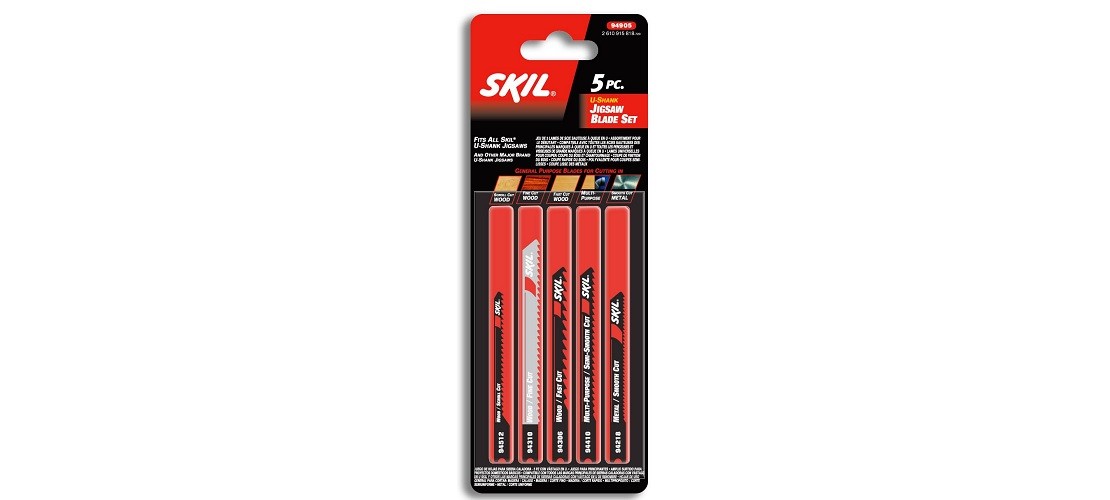
This small set has blades able to cut curves and straight lines in the wood. There are a multipurpose unit and a short metal blade. These SKIL jigsaw blades fit most of the U-shank-equipped and combined type jigsaws.
The scroll cut blade is thin and cuts through softwood without effort. It has medium-sized teeth and produces a little sawdust. So does the long wood blade designed for fine straight cuts. When operated slowly, it leaves no splinter and makes fine crosscuts.
The blade with the large and few teeth serves for fast straight cuts through wood and composites. The metal blade can saw through a thin metal sheet and plastic. The multipurpose blade slices equally well through the plywood and thin metal.
Pros
- Durable high-quality build and solid shank construction.
- Longer blades feature pin-sharp teeth making a fast and smooth initial stroke.
- These thin jigsaw blades are comprehensively labeled with their type and number; color-coded.
Cons
- Blades don’t bend but can break at additional pressure against hard material.
- The package doesn’t fit for storing the used blades securely.
Buyer’s Guide
T Shank vs U Shank Jigsaw Blades
What is the difference between T shank and U shank metal jigsaw blades? The construction type defines the way the blade is fixed on the jigsaw head. Some jigsaws have a combined mechanism that allows operating both T-shank and U-shaped blades. However, most frequently, a jigsaw is dedicated to a certain type which is also determined in its specification.
The U-shank blades are held inside the jigsaw tool by means of the horizontal screw mechanism. These blades need an Allen key or another tool to be removed or installed.
The T-Shank jigsaw blades are inserted into the vertical screw mechanism. They are inserted manually. It is the most popular type of blades used in modern jigsaws.
How to Change a Jigsaw Blade
Blade exchange can vary in jigsaws having different blade holding mechanisms.
- With tool-requiring mechanisms, use the Allen wrench to unscrew the bolt holding the clamp. Then using the pliers take out the blade. Position a new blade with its teeth facing in front of the jigsaw, into the clamp. Screw the bolt in. Ensure the blade sits tightly.
- With a tool-less clamp, bend the lever disengaging the blade or ejecting it from the jigsaw head. Take the blade out with pliers. Holding the lever, put a new blade into the clamp. Release the lever and check if the blade sits firmly.
How Thick of Wood Can a Jigsaw Cut
The depth of cut made by a jigsaw blade depends on the workpiece material, length, build, TPI, and specialty of the blade.
- Material. HCS blades are usually used for wood. HSS blades can cut through hardwood and thin metal. Bi-metal units can deal with thicker metal, while tungsten carbide cut ceramics and thick steel.
- TPI. The blades with TPi 6 to 20 are made for wood, while TPI 14 to 36 usually serves for metal.
- Specialty. The reverse and plunging blades are designed to make deeper cuts than regular straight and scrolling blades.

